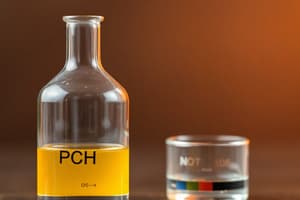Podcast
Questions and Answers
What is an example of a primary alcohol?
What is an example of a primary alcohol?
- Phenol
- 2-Methyl-2-propanol
- Ethanol (correct)
- 2-Propanol
Which one of the following is a secondary alcohol?
Which one of the following is a secondary alcohol?
- Phenol
- Ethanol
- 2-Propanol (correct)
- 2-Methyl-2-propanol
Which of the following is an example of a tertiary alcohol?
Which of the following is an example of a tertiary alcohol?
- 2-Methyl-2-propanol (correct)
- Ethanol
- Phenol
- 2-Propanol
Phenols do not resemble alcohols structurally.
Phenols do not resemble alcohols structurally.
What is one property of phenols?
What is one property of phenols?
What is a property of alcohols?
What is a property of alcohols?
What does the Chromic Acid Test distinguish?
What does the Chromic Acid Test distinguish?
What does the Lucas Test distinguish?
What does the Lucas Test distinguish?
Flashcards are hidden until you start studying
Study Notes
Classification of Alcohols
- Primary Alcohol: Contains one alkyl group attached to the carbon with the hydroxyl group; example: Ethanol.
- Secondary Alcohol: Contains two alkyl groups attached to the carbon with the hydroxyl group; example: 2-Propanol (isopropyl alcohol).
- Tertiary Alcohol: Contains three alkyl groups attached to the carbon with the hydroxyl group; example: 2-Methyl-2-propanol (t-butyl alcohol).
Phenols
- Structurally similar to alcohols due to the presence of a hydroxyl group.
Properties of Phenols
- More acidic than alcohols.
- Concentrated phenol solutions are toxic and can cause severe skin burns.
- Polar and generally mixes with water.
Properties of Alcohols
- Alcohols mix well with water.
- Increased number of hydroxyl groups enhances water solubility due to more hydrogen bonding.
- Also soluble in organic solvents.
Chromic Acid Test
- Distinguishes primary and secondary alcohols from tertiary alcohols.
- Uses acidified dichromate solution where:
- Primary alcohols oxidize to carboxylic acids.
- Secondary alcohols oxidize to ketones.
- Tertiary alcohols do not oxidize, showing no reaction.
- The color change from red/brown to blue/green indicates oxidation.
- Phenols oxidize to a brown tarry mass.
Lucas Test
- Differentiates water-soluble primary, secondary, and tertiary alcohols using Lucas reagent (ZnCl2 in HCl).
- Tertiary alcohols react rapidly, forming an insoluble white layer immediately.
- Secondary alcohols react slowly, forming a thin white layer after slight heating within 10 minutes.
- Primary alcohols do not react.
- Positive results show a heterogeneous phase or emulsion.
Studying That Suits You
Use AI to generate personalized quizzes and flashcards to suit your learning preferences.




